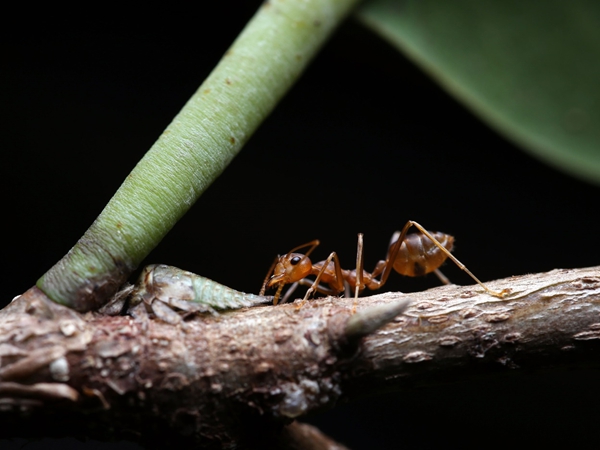Ants (Hymenoptera: Formicidae) are among the most diverse and abundant insects on this planet. Both native and invasive ants are capable of forming mutualisms with hemipteran insects, preying on non-hemipteran herbivores and indirectly affecting primary production. To date, most research has focused on only one or two levels of interaction between ants, other arthropods, and plants, and few studies have focused on the potential effects of ant-hemipteran trophic interactions as a whole.
In a study published in Agronomy, researchers from Xishuangbanna Tropical Botanical Garden (XTBG) conducted three related meta-analyses based on data from invasive or native ant exclusions and resultant measures of hemipteran abundance, herbivore abundance, and plant fitness (measures on plant performance and reproduction).
To test the direct and indirect ecological consequences of ant exclusions, they conducted commonly exclusion experiments and compared with a control (ant presence).
The data showed that, for each category and each level of category, the exclusion of ants significantly reduced hemipteran abundance, indicating an intimate relationship between both groups of ants and hemipteran insects. Invasive ants also showed a significantly stronger relationship with Hemiptera than native ants in shrubs. Invasive ants relied more on Hemiptera in shrubs in tropical areas than native ants.
The results support the “mutualism intensity” hypothesis, that the exclusion of both native and invasive ants had significant effects on hemipteran abundance, and invasive ants had significantly stronger effects on hemipteran abundance than native ants. Both native and invasive ants had significant effects on herbivore abundance, but the effects of invasive ants on herbivores are equal to those of native ants. Additionally, the effects of ants on parasitoids and predators were not significant.
Moreover, plant fitness (e.g., leaf area, plant height, and seed production) was significantly reduced when native ants were excluded; the exclusion of invasive ants did not influence plant fitness. Cascading effects of native ants on plant fitness were significantly positive, but there was no significant impact of invasive ants.
“These findings suggest a weak relationship between the presence of invasive ants and non-hemipteran herbivore abundance. We suggest that the hemipteran–ant mutualism could represent a ‘symbiotic invasion’” said WANG Bo of XTBG.
Contact
WANG Bo Ph.D
Key Laboratory of Tropical Forest Ecology, Xishuangbanna Tropical Botanical Garden, Chinese Academy of Sciences, Mengla, Yunnan 666303, China
E-mail: wangbo@xtbg.ac.cn

Hemipteran–ant mutualism (Image by WANG Bo)

